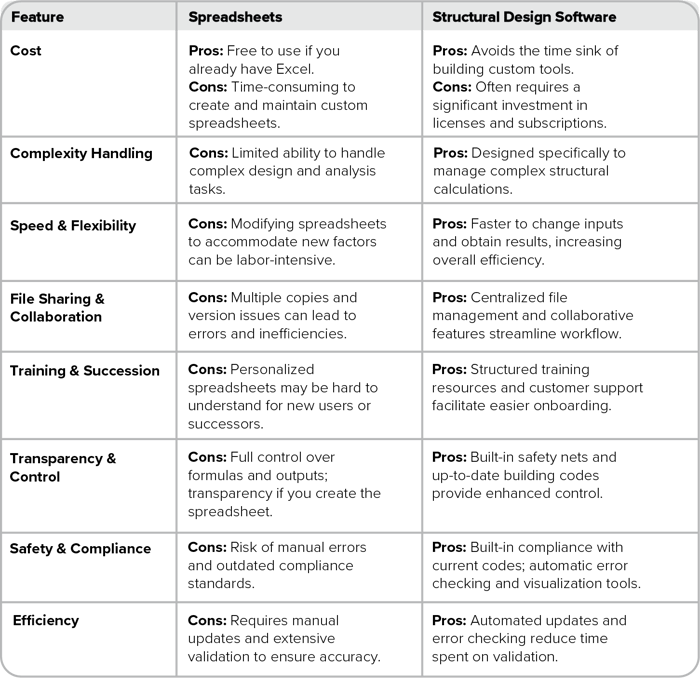If you’re a structural engineer, chances are you’ve spent a fair amount of time tinkering with Excel spreadsheets. They’re incredibly handy for quick calculations, like determining load capacities, checking code requirements or designing individual specialty components. In fact, many professionals use spreadsheets to perform tasks that are quite similar to those done by specialized structural design software. This raises an interesting question:
Why should a structural engineer invest in software when spreadsheets seem to get the job done?
It's a fair point, so let’s break it down.
Comparison side-by-side

Want to learn more about the benefits of structural software?
Why Use Spreadsheets for Structural Design & Analysis?
It Costs Nothing But Your Time
Spreadsheets are like the Swiss Army knives of structural design. They’re free, versatile, and, with enough effort, you can tailor them to meet your exact needs. You might even find templates online, although the quality can vary widely. However, be prepared to invest significant time upfront in creating, refining, and maybe even coding some macros or VBA scripts. But once it’s set up, you’re off to the races.
Potentially More Transparency
When you build your own spreadsheet, you know it inside and out. Every formula, every input and output—it’s all laid bare for you to see. In a field where safety is paramount and getting it wrong can be catastrophic, transparency is essential. You need to trust your tools completely.
Of course, this transparency comes with a caveat: you must double-check your work. Whether you’re building from scratch or using someone else’s template, always verify results with hand calculations or reliable software.
More Control Over Reports
Spreadsheets offer another advantage: you control what you show in your reports. Want to highlight a specific calculation? With a spreadsheet, you can easily customize the data you present. Some software might limit your reporting options, but with Excel, you’re in the driver’s seat.
Why Use Structural Design & Analysis Software?
You Don’t Have to Build It
One of the biggest draws of software is that it saves you time. In an industry where deadlines loom and projects stack up, every minute counts. With software, you bypass the hours—sometimes days—spent building and testing a spreadsheet. You can jump straight into the design work.
Handle More Complexity with Ease
While Excel is powerful, it has its limits. Structural design software, on the other hand, is purpose-built to handle the complex demands of engineering. Whether it’s modeling intricate structures or running detailed analysis, the right software can handle tasks that would push Excel to its breaking point.
Speed and Flexibility
Software isn’t just about handling complexity; it’s also about doing it faster. Need to make a change? Adjust a few inputs in your software, and you’re done. In a spreadsheet, such changes might require a complete overhaul of your formulas. With software, you can iterate quickly, allowing more time for fine-tuning your designs.
Streamlined Workflow with Shared Files
One of the hidden dangers of spreadsheets is version control. Multiple users often mean multiple versions, leading to duplication of effort and an increased risk of errors. Structural design software solves this by ensuring everyone is working from the same file. Plus, it eliminates compatibility issues that can arise with different versions of Excel.
Easier Training and Succession Planning
Spreadsheets often carry the personal touch of their creator—sometimes too much so. When a key team member leaves, their highly customized spreadsheet might become a cryptic puzzle for their successor. Software vendors typically offer extensive training resources, ensuring that even new hires can quickly get up to speed without spending weeks deciphering someone else’s work.
Built-in Safety Nets
And let’s not forget the most critical aspect: safety. Proper structural design is non-negotiable—it’s about protecting lives. Software helps mitigate risks by keeping building codes up to date, flagging nonsensical inputs, and providing visualizations that make it easier to spot potential issues. Moreover, many programs offer audit trails, tracking every change made, which is crucial for both accountability and long-term security.




